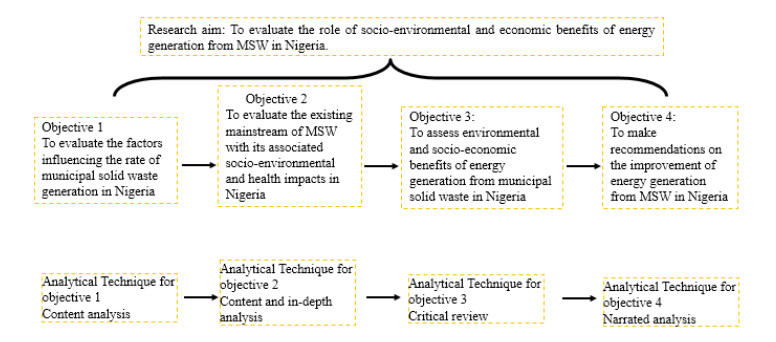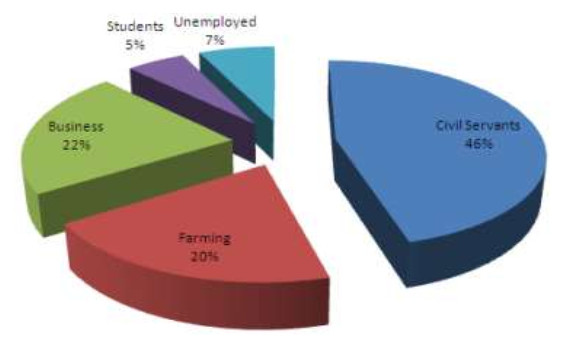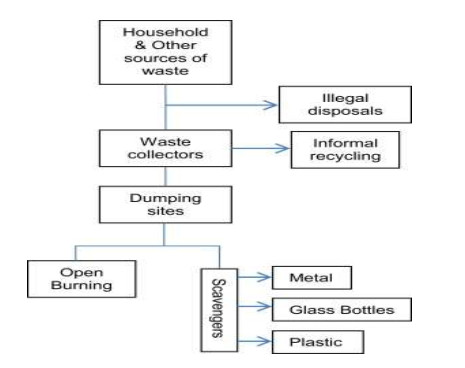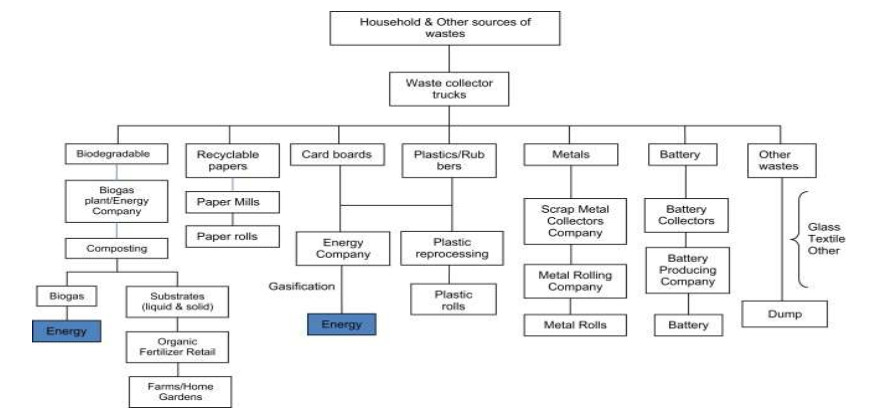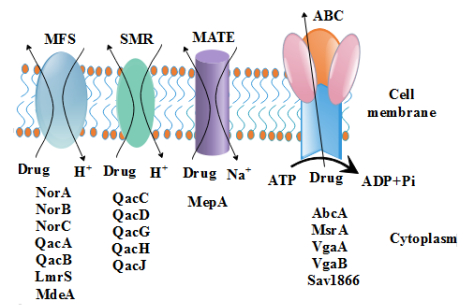1.
Introduction
A developing country such as Nigeria is experiencing enormous environmental and socio-economic challenges due to increased production of municipal solid waste (MSW) that is mostly attributed to urban population growth and rural to urban migration [1]. In Nigeria, the management of MSW disposal through the method of open dumping has become the routine management option of managing MSW [2,3]. However, the current waste management system in Nigeria follows the principles of collection-transportation and open dumping out of the city boundaries in conformity with the concept of “out of sight out of mind” [4]. In other words, Nigeria does not have a centralised system of MSW with extensive recycling and resource recovery [4]. Abel and Afolabi [5] argued that Nigeria is a developing country that constitute of 36 states with a population of about 160 million people and an estimate of 0.58 kg of municipal solid waste generation/person per day.
In Nigeria, the private waste collection services such as Girl-Child Scavenger in Ibadan Oyo state and public sectors such as Oyo State Waste Management Authority (OYSWMA) have initiated several procedures for collecting waste in many states whose effectiveness is ultimately influenced by location and household income in order to be able to afford expenses involved in rendering these services [7]. MSW in Nigeria is generally characterised by inadequate handling and coverage of the collection system, inefficient method of collection, and inappropriate waste disposal [8]. According to Arukwe et al. [4], it is widely observed that MSW disposal practices in Nigeria are a direct consequence of a combination of lack of waste separation at point source, lack of modern technology, political and individual willingness and strength for solid waste management policy and enforcement, effective monitoring and control, household income and adequate environmental awareness and education. This is further supported by a study conducted by Abel [5], who opined that income, education and social status were the key factors influencing per capita MSW production in Ogbomoso, Oyo state Nigeria.
Furthermore, Ajani [9] also posited that location, age, occupation and price for waste collection influenced the use of public waste collection services in Ibadan, Oyo state such as the Oyo State Waste Management Authority (OYSWMA). Therefore, it is important to note that large production on MSW may be a potential harmful source of contaminants to receptors (surrounding environment and humans) if not properly contained at disposal sites [4]. Increase in the generation of MSW poses some serious environmental and human health hazards through contaminant releases from waste-disposal sites [4]. Contaminants such as phthalates, bisphenol-A, non-ionic surfactants such as Alkylphenol Polyethoxylates (APEs), Pharmaceuticals and personal care products (PPCPs), and Perfluorinated Compounds (PFCs), have been reported to be detectable in most environmental matrices [10] and in biota [11]. In other to mitigate the potential adverse effects on environmental and human health issues arising from contaminants released from uncontrolled dumpsites of MSW in Nigeria, a sustainable management of MSW is highly recommended.
There are several sustainable waste management practices such as recycling, reuse, resource recovery etc. This research focuses on the role of energy generation from MSW in Nigeria using multiple case studies as energy generation from MSW generation is an important part of development related to environmental and health protection.
2.
Materials and method
2.1. Study area
Nigeria a developing country in the West African region which constitute of 36 states with its state capital Abuja as indicated in Figure 1. Nigeria situated in the West African region lying between longitude 3 ℃ and 14 ℃ and latitude 4 ℃ and 14 ℃, with a landmass of 923768 sqkm. It shares borders to the west with republic of Benin, Niger and chad to the north and down to Atlantic Ocean to the south. Nigeria has a relative high temperature with a narrow variation in seasonal and diurnal ranging from (22–36 ℃) with two seasons, wet season from April-October and dry season from November- March of every year. The extremes of the wet season is felt on the south-eastern coast where annual rainfall might reach 330cm while the extremes of the dry seasons in aridity are felt in the northern side of the country. In line with the climate and rainfall distribution, there are two broad vegetation types, Forest vegetation such as rainforest savannah favouring the growth of timber, oil palm, cocoa among others and Savannah vegetation consisting of Guinea and Sudan savannah favouring the growth of major grains, grasses, tuber, vegetables and cottons [6].
2.2. Research design
This research is an exploratory research that relied solely on the use of secondary data in data collection and analysis. This research is an investigative research because it derives the factors influencing the rate of MSW generation in Nigeria to evaluate the existing mainstream of MSW with its associated socio-environmental and health impacts in Nigeria.
In addition, this research also assessed the economic, social and environmental benefits of energy generation from municipal solid waste in Nigeria and made recommendations on the improvement of energy generation from MSW in Nigeria. Figure 2 illustrates the objectives of this study with the various analytical tools that was used to achieve the set objectives of this study.
2.3. Data collection
The approach adopted secondary data collection in this research and is referred to as “unobtrusive measures”. According to Webb et al. [12], inconspicuous measure is a method of data collection that does not require the cooperation of the subjects and, in fact, may be invisible to them. However, unobtrusive measures can also be referred to as “nonreactive research” because the researcher is required to gather data without getting involved with respondent’s interaction with the measure used [13]. Unobtrusive measures were engaged in this research because the secondary data used were gathered without interference [12]. This method of data collection was also suitable in this research because there was no possibility for the Hawthorne effect (observer effect) and it is conducive to examining processes [14], and in this case, the processes of examination in this research are the factors influencing MSW generation and the existing mainstream of MSW management in Nigeria. However, the limitations encountered by adopting this method is that there were potential issues with limited data availability but the research scope was broadened and an in-depth advanced search was undertaken so as to access various data beyond the research surface [12]. This was used to reduce the risks of adopting the unobtrusive measures as a method of data collection. This decision produced a deeper understanding and produce valid result after analysis. The following are the parameters or variables gathered for the various objectives of this research.
2.4. Data analysis
In this research, four major analytical tools were adopted for data analysis which includes: content analysis, critical review, in-depth analysis and narrative analysis.
For this study to achieve Objective 1, the analytical technique adopted for data analysis was content analysis. Content analysis was considered the suitable method of data analysis because this method consists of a “reflexive analysis of the documents” [15]. The various parameters gathered for objective 1 were tabulated as shown in Table 1 and categorised into themes such as social, economic, political, environmental and technological factors and various specific parameters were coded from 1 to 5.
To achieve objective 2, a content and in-depth analysis of the secondary data or parameters were gathered. These parameters tabulated as indicated in Table 1 were categorised into three themes: social, environmental and health impacts arising from the existing mainstream MSW management in Nigeria. Various parameters are assigned into each theme.
The parameter or data gathered so as to achieve the third objective were critically reviewed. As illustrated by Table 1, these parameters were classified into three broad benefits, namely; environmental, economic and social benefits. These benefits were critically analysed to justify the benefits of energy generation in socio-environmental and economic perspective and in that lens, objective 3 was achieved.
Some parameters such as the provision of advanced technology, promotion of environmental education, stringent enforcement of solid waste management policies, development of WTE institutions, colleges or workshops which were gathered were narratively analysed critically so as to demonstrate how energy generation from MSW can be improved in Nigeria were some of the parameters used to achieve the fourth objective.
3.
Results and discussion
3.1. Factors influencing the rate of municipal solid waste generation in Nigeria (Objective 1)
There are many factors influencing the rate of MSW in Nigeria [16]. Various variables such as urbanisation or urban expansion, income level and industrialization, poverty, lack of government support, inadequate environmental policy and planning, normal MSW recycling and lack of science and technology were gathered from peer reviewed waste management, and environmental management journals from Coventry University’s e-library database such as Science direct, Scopus and Sage. These data were gathered after undertaking a critical review of over 15 peer reviewed journals written in MSW in Nigeria and other developing countries. Table 2 shows some of the factors that influence MSW generation in Nigeria.
3.1.1. Social Factor: Urbanization or urban expansion
There is an unprecedented growth in cities in recent times in Nigeria and this has resulted in urbanization or urban expansion [17]. According to Agunwamba [18], this growth has been put at 3.6% per annum despite the fact that a higher growth figure of above 6% has been recorded in major cities (Lagos, Ibadan, Kaduna, Port-Harcourt and Warri) in Nigeria. The UN Habitat [19] estimated that 374.4million people reside in the cities in Africa in 2007 and by 2030, it is expected to increase to 759.4million and to 1.2 billion by 2050.
3.1.2. Economic Factor: Income level and Industrialisation
Income level as stated by Repettor et al. [20] stated that, in a society income influences the type and volume of MSW to be generated. The study revealed that when the income level is high, there would be a larger proportion of non-organic, toxic and non-biodegradable MSW, most especially packaging materials, glass, papers and metals. The influence of income level in MSW was also evaluated using the population of Bauchi metropolis as a case study and the results of the research revealed that 46% of the household breadwinners in Bauchi metropolis were civil servants as indicated in Figure 3 while up to 20% were farmers and a proportion of 7% were unemployed as indicated in Figure 3 [21].
Studies by Bogoro [21] revealed that the high proportions of civil servants in Bauchi who are mostly low income and peasant farmers as indicated in Figure 4 are responsible for the increase in the generation of MSW in Bauchi metropolis, although the MSW generated from these civil servants are mostly made up of organic nature such as vegetables. Income level plays a vital role in municipal solid waste generation in various towns in Bauchi as indicated in Figure 4 vis-a-vis its evacuation.
3.1.3. Environmental Factor: Inadequate environmental policy and planning
In Nigeria, virtually all state governments have demonstrated an increase in the mitigation of MSW generation in most cities, however large volumes of MSW is still being generated [22]. As the problems of MSW in most cities in Nigeria are also attributed to the increase in population and economic growth [3], inadequate environmental policies and planning are also contributors to the generation of MSW in most of the cities [22]. As revealed in fig. 5, the principle of the polluter pays in Nigeria is either ineffective or weak and this increases the act of fly tipping, informal recycling and illegal waste dumping in most cities [3].
3.1.4. Technological factor: Informal MSW recycling and lack of science and technology
Presently in Nigeria, the management of MSW simply involves the transportation of MSW from one location, such as the point of collection, to a designated landfill site in remote outskirts [23] as shown in Figure 6. This practice is predominately inherent in all the 36 states in Nigeria due to lack of the application of science and technology as a sustainable management system of municipal solid waste [22]. Bonner, [24] stated that the application of science and technology in the management of MSW in Nigeria would reduce the generation of MSW and various risks associated with waste picking without frontiers.
According to UN Habitat [26], the causes of MSW accumulation due to informal MSW recycling results from and is sustained by a failure of the governance system [27]. Adama [28,29] also contend informal MSW recycling workers do not operate in a vacuum or abide by environmental laws. Therefore, these informalities although could be perceived as an overall failure in governance [28], it can also be perceived as a key factor influencing the generation of MSW in Nigeria. Hence it is essential to apply the various science and technology to enhance sustainable MSW management. This can be achieved by waste compositing, energy recovery from MSW and green or formal recycling of MSW [29].
3.2. Existing mainstream MSW management in Nigeria (Objective 2)
The parameters gathered includes: GHGs emissions, illegal burning, anaesthetic surrounding, no response to environmental consideration or regulation, open burning, lack of protective equipment such as gloves and boots, direct contact with hazardous waste, dermatological issues, eye infections and low life expectancy, discrimination, harassment, stigmatization and isolation, unhygienic, homeless, nuisances and poverty-stricken. These data were gathered after undertaking a critical review of over 15 peer reviewed journals written in MSW in Nigeria and other developing countries from Coventry University’s e-library and over 15 government publications written on MSW, informal recycling and activities of scavengers in Nigeria.
Two pillars that support the urban economy are the formal and informal sectors [30]. The public and private sectors which are legally industrialised and modern are categorised into the formal and this sector is often supported financially by government agencies [25]. Figure 7 demonstrates the existing mainstream of MSW management in most cities and towns across Nigeria which is considered as the informal sector in MSW in Nigeria. In Figure 7, it is discovered that the activities of the informal sector of MSW are not extended to energy generation from MSW but limited to MSW collection by scavengers, illegal dumping and informal recycling of MSW.
According to Gutberlet and Baeder [31] underdeveloped countries have several valuable economic benefits arising from an informal sector of MSW management and these economic benefits determines the direction of the whole economy. Gunsilius [32] opined that one of the economic benefits of the informal sector recycling in Nigeria is the creation of new enterprises and trading networks for investments to take place. As shown in figure 7, the participant involved in the informal recycling of MSW in Nigeria ensures that constant and reliable supply of valuable secondary raw materials to local industries (such as recycled plastic pellets) are delivered [33]. Furthermore, this substitutes the cost of importation of new materials and thus stimulates a decrease in price of goods and services in the local community [34].
This also increases informal employment opportunities and also encourages self-entrepreneurship in Nigeria [27]. According to Nzeribe [27] the monthly income of MSW pickers in some cities in Nigeria as indicated in Table 3 is greater than the minimum wage. However, the MSW pickers’ income generated does not immediately re-enter the economy as they do not pay taxes. The International Solid Waste Association (ISWA) report of 2014 titled ‘Wasted Health, The Tragic Case of Dumpsites’, stated that the human environmental rights were not included in the Universal Declaration of Human Rights in 1948 and in many subsequent human rights treaties. Human populations are growing, people are moving around the planet more and there is an exponential increase in MSW production. With these changes, it is imperative for the Nigerian government to offer a safe, clean, healthy, and sustainable environment for its citizens as their human right.
Despite the economic benefits of the activities involved in the informal sector of MSW, there are some socio-environmental and health issues arising from the existing informal sector of MSW management in Nigeria. As shown in Table 2, thematically categorises the various impacts into environmental issues, health issues and social issues and various parameters under each category are used in evaluating the socio-environmental and health impacts arising from this sector.
3.3. Issues arising from the existing mainstream MSW management in Nigeria
The various themes categorised into environmental, health and social impacts as indicated in Table 2 arising from the existing mainstream MSW management in Nigeria are evaluated as follows.
3.3.1. Environmental impacts
Illegal dumping of MSW as indicated in Figure 5 results in widespread contamination and anaesthetic surroundings [34]. Open burning results in increased anthropogenic rate of GHG emissions into the atmosphere and this is one of the principal objectives of generating energy from MSW to combat the effects of fossils fuel combustion [35]. Therefore, in as much as the existing mainstream MSW does promote economic survivals of scavengers, it does not promote environmental pollution and prevention control. This calls for the need for energy generation from MSW in Nigeria as it offers various benefits such as reduction in environmental pollution, health issues, social issues and creation of employment opportunities.
3.3.2. Health issues
Apart from the environmental impacts of existing mainstream MSW management in Nigeria which excludes energy generation, several health impacts such as the scavengers inhaling toxic GHGs emissions and bio-aerosols results in respiratory issues [34]. Ezeah et al. [3] argued that there are several health risks arising from the informal recycling of MSW in Nigeria as most scavengers are prone to dermatological issues, eye infections and low life expectancy from prolonged exposure to potential toxic substances [34]. Wilson et al. [34] and Ezeah et al. [3] stated that this is true because most scavengers have little or no knowledge of occupational health and safety [3]. Therefore, they are exposed to health hazards due to lack of adherence to protective equipment such as gloves and boots. As a result, they may be exposed and have direct contact with sharp items such as (broken glass, needles) and toxic chemicals that may arise from hospital wastes [16]. Most scavengers with direct contact with these items are also vulnerable to the transmission of some diseases such as HIV and HBV, leishmaniasis, diarrhoea, typhoid, anthrax, cholera, and malaria [33].
3.3.3. Social impacts
Although the existing mainstream of MSW management in Nigeria provides employment and a livelihood for impoverished and vulnerable social groups, these groups tend to survive in a very hostile physical and social environment [23]. This is due to the fact that some part of the public does not recognise the activities of scavengers as a legal way of resource recovery from MSW [31] and these scavengers tend to be discriminated, harassed, neglected and embarrassed [36].
Some social issues such as discrimination and harassment arising from the public such as the police and host communities are due to the fact that these scavengers are considered to be criminals, unhygienic, homeless, nuisances, poverty-stricken as such that they are incompatible in adopting the technological way of MSW management system such as energy generation [34]. These social impacts reinforce the low social status of the scavengers thus, resulting into isolation, stigmatization, and development of some customs, beliefs, values, habits, and social networks by scavengers [31]. This also promotes illegal recycling of MSW which impedes the energy generation from MSW, increase environmental, health and social impacts of scavengers. Therefore, the concept of developing energy from waste should be advocated as it does not only ensure energy security, pollution prevention through environmental clean-up, it also creates employment opportunities and mitigate the environmental, social and health issues arising from informal recycling in Nigeria.
As shown in Figure 8, it demonstrates in summary the interconnectedness of the economic, environmental, health and social impacts of the existing mainstream of MSW management evaluated as stated in objective 2 with energy generation from MSW management in Nigeria.
3.4. Environmental and socio-economic benefits of Energy generation from MSW in Nigeria (Objective 3)
Parameters such as GHG mitigation, provision of decentralized electricity system from Biogas from MSW in Nigeria, promotion of rural economies and create employment opportunities were gathered for an assessment of the economic benefits of waste to energy from peer reviewed waste management, and environmental management journals from Coventry University’s e-library database such as Science direct, Scopus and Sage after a critical review of over 10 literatures on MSW management, environmental and renewable energy. Electricity generation using MSW has several benefits in Nigeria and these benefits are broadly classified into three categories, namely; environmental, economic and social benefits.
3.4.1. Environmental benefits
In Nigeria, energy generation from MSW offers huge benefits in the mitigation of GHGs and provision of decentralized electricity system from Biogas from MSW in Nigeria. However, it is essential to highlights some WTE technologies which can enhance energy generation from MSW and also some environmental benefits. The following are various WTE technologies.
3.4.2. Combined heat and power (CHP)
Energy can be generated from an integrated system referred to as combined heat and power (CHP) which simultaneously generates electricity and heat from combusted biomass. In other to produce energy from MSW, the biomass from MSW is oxidised in the presence of excess air to produce flue gases, biogenic carbon dioxide (CO2) and water (H2O). However, the hot flue gases in this facility are used to produce steam, which activates a turbine to generate power typically as a topping cycle [37].
The heat generated from the waste is then recovered to provide extra thermal energy that can be used in industrial processes or district heating system while the hazardous compounds are concentrated in the ashes for safe disposal in dump sites [38]. Various hazards such as surface water contamination, ground water contamination, poignant odour, release of greenhouse gases, accidental hazard caused by fire, slope instability and Soil contamination occurs in Dump sites [39].These problems are as a result of the lack of leachate collection and treatment, insufficient provision of liner, shortage of cover and poor site design or no design [40].
3.4.3. Anaerobic digestion (AD)
Anaerobic digestion is a WTE technology which involves a biochemical conversion processes to producing fuel for energy through an enclosure called a digester. This technology is currently used in some developed and developing countries for the treatment of both dry and wet biomass resources and to convert MSW into energy. It has been successfully used to generate electricity for rural and remote areas of developing countries such as Algeria [41].
3.4.4. Incineration
Another WTE technology for the conversion of MSW to energy is incineration. This technology involves burning or combusting of the whole mass of waste in an incinerator. One of the advantages of incineration of MSW is that it can drastically reduce the volume of MSW by up to 80% to 90% [23].
3.4.5. Provision of decentralized electricity system from Biogas from MSW in Nigeria
Previous studies of some authors such as [42] and [43] reported that over 50% of wastes from commercial and household sources in municipalities in Nigeria are biodegradable organic waste that can be fed into bio-digesters for biogas production. Abila [44] opined that one of the advantages of biogas production from MSW is that it is healthier, cost effective and easy to manage.
Biogas production which is mainly produced from anaerobic digestion (AD) of biomass or organic materials particularly from the MSW is an innovation strategy to solve electricity generation in Nigeria. Markard [45] stated that biogas production from MSW is a “matured technology and a radical innovation in electricity generation because of its decentralized natured”. However, the electricity generation decentralization is a common practice in Nigeria [44] considering the inadequate electricity supply to business, homes and also power generation from small to medium capacity generators in Nigeria. Instead of fuelling these generators with combustible fossil fuels such as diesel and petrol, biogas from MSW which is cleaned can be used as a greener alternative for these generators in Nigeria.
Furthermore, instead of purchasing and maintaining electricity generators by individuals or businesses, a mini-grid option which is fuelled using biogas can be installed in a community. This type of decentralized electricity system is a solution for less effective centralized grids currently in existence in Nigeria for meeting both household and commercial energy needs.
In Omi-Adio village, Iddo Local Government in Ibadan, Oyo state, the waste dumped in an open village can be separated to allow for the differentiation of wastes into the various categories based on characterization that will determine their appropriateness for energy recovery [46]. Organic wastes constitute over 50% for wastes from household and commercial sources in municipalities in Nigeria [23] and Onwughara [47] added that in Ibadan Oyo State, the organic wastes are mainly biodegradable materials that can be fed into bio-digester for biogas production as indicated in Figure 9. Biogas production from anaerobic digestion (AD) of organic waste in Omi-Adio village in Ibadan, can be considered as the next crucial innovation phase in the quest to solve electricity generation in this Village
Household wastes in villages have ample generation of biodegradable wastes that can be used in constructing small unit bio-digesters for generating the biogas needed for fuelling their generators when electricity supply from the main grid is cut-off [44].These MSW dumped in an open site in this village can be gathered and closed landfill and bio-digesters on the dumpsites can be constructed to produce a clean and compressed biogas through anaerobic digestion for filling retail gas-cans in this village. However, this enhance electrical generation in Omi-Adio area of Iddo Local Government in Ibadan, Oyo state, Nigeria because when the community scale off-grid electricity generation is plausible, the constructed landfill for biogas production in this area can be the source of fuel for such projects.
Biogas production through anaerobic digestion for electrical generation is the most suitable WTE technologies suitable to mitigate the issues of power generation in Nigeria most especially in Omi-Adio village of Iddo Local Government in Ibadan, Oyo state, Nigeria. This is because of the abundant biodegradable wastes that can be harnessed for energy production for the direct use in cooling, cooking and lightening. Also due to the availability of massive municipal solid wastes from a local abattoir in Ibadan which is increasingly becoming nuisance [48].
Other WTE energy technologies such as incineration and CHP can also be used in electrical generation but the use of incineration is not suitable in this village due to the increasing level of GHGs that is already a big concern in Omi-Adio village of Iddo Local Government in Ibadan, Oyo state, Nigeria [47]. However, the implementation of CHP is also considered also suitable because of its potential mitigate the emissions of GHGs in this village.
Therefore, implementation of anaerobic digestion and combined heat and power is not limited to this village but can be adopted in other villages in Nigeria as this will ensure efficient management of MSW arising as a result of increasing rate of urbanization in Nigeria.
3.5. Improvement of energy generation from MSW in Nigeria (Objective 4)
In order to maintain the economic, environmental and social benefits of energy generation from MSW, it is essential to adopt strategies to enhance the generation of WTE from MSW by adopting the following strategies:
● Provision of advanced technology to enhance Waste to Energy (WTE); in order to improve energy generation from MSW in Nigeria, there is need to provide adequate advanced technology to enhance the conversion of WTE. According to Nigerian road Map [49] electricity supply is below 4MW which is incapable to cater for the population of over 150 million people thus the need for an alternative energy supply.
● Adequate enforcement of solid waste management policy in Nigeria; every waste material passes through a long cycle which consists of several activities resulting in greenhouse gas emissions. However, the impact of this neglect includes increase in the risks of flooding, vermin and pests’ distribution and destruction of air quality, soil fertility and infrastructural disruption. Therefore, it is essential to adequately maintain and enforce a solid waste management policy in Nigeria to promote a sustainable management of MSW such as waste conversion to energy in Nigeria [49]. Enforcement of solid waste management policy in Nigeria will promote an anaerobic digestion of MSW in various landfills so as to produce biogas, also promote other sources of technology such gasification and pyrolysis of generating energy from MSW in Nigeria.
● Promotion of environmental awareness: According to Bogoro [21] environmental awareness is a strategic tool used to disseminate the significance of waste management although it is not enough for people to be aware of the need MSW management, but there is the need to educate the public on how to convert these MSW to energy, new products etc as these are sustainable solutions in curbing waste generation in Nigeria.
4.
Conclusion
Informal MSW recycling is also a contributor to inadequate energy generation from MSW. This is due to some activities such as waste collection from one area to another by waste pickers that hinders waste differentiation into the various categories based on characterization.
WTE technologies such as anaerobic digestion (AD) and combined heat and power (CHP) is a promising and viable MSW management strategy which can be adopted in most villages in rural areas in Nigeria. Energy generation from MSW plays a significant role in the economy contributing to economic stability, social role in reducing discrimination faced by informal MSW. In Nigeria, energy generation from MSW plays both positive and negative role. The positive role can be perceived as reduction of GHGs emissions in an environmental perspective, creation of employment opportunities in economic perspective and social perspective in terms of reduction of discrimination, harassment faced by MSW pickers in the informal recycling sector. The negative role of MSW can be viewed in terms of constituting environmental damages such as land contamination and health hazards.
However, in to enhance the role of energy generation in Nigeria, the government and private initiatives are required to make the necessary inputs available. These inputs from the government or private sector do not necessarily have to be financial. Some of these inputs may be environmental campaigns sponsored by the government in Nigeria encouraging Nigeria citizens to co-operate in appropriate waste separation and waste disposal. This will enhance adequate MSW differentiation and characterisation for energy generation.
Also, implementation of adequate MSW management cannot be effective without proper monitoring of its disposal activities. Therefore, it is essential to monitor the disposal activities of MSW on regular basis to reduce its environmental and health hazards. There is also an urgent need to reassess all legislations regarding waste management in Nigeria with the aim of streamlining them in such a way to promote various WTE technologies most especially anaerobic digestion (AD) and combined heat and power (CHP). These technologies are most suitable in Nigeria where the emissions of GHGs are rapidly increasing due to over-dependency on fossil fuel.
Conflict of interest
The authors declare no conflict of interest, financial or otherwise.
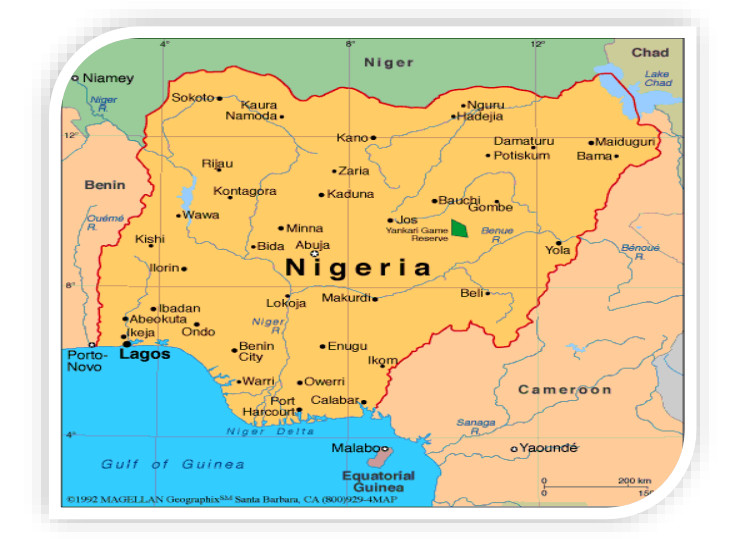









 DownLoad:
DownLoad:
